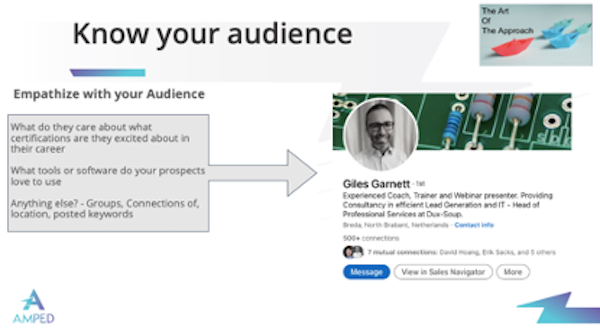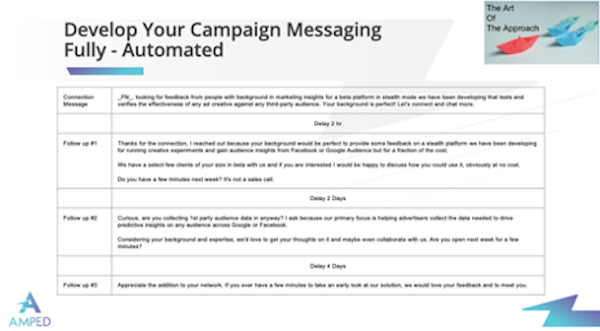So, you’re using LinkedIn to grow your network, but find yourself asking, ‘What’s the best way to generate leads that turn into sales appointments’?
Well, look no further, as we introduce you to Scott Wright, former ‘professional’ cold-caller, turned Dux-Soup Head of Sales and LinkedIn lead gen expert. Co-Founder and COO of AMPED Marketing, Scott is a self-taught expert when it comes to lead generation automation. He’s responsible for scoring 350 sales appointments in just 3 months, and his ability to communicate is sending his clients’ sales figures soaring.
Imagine then, our excitement when Scott agreed to host a Dux-Soup webinar in November, to let our users in on the secrets of his amazing success. His webinar was crammed with expert advice and generously shares his perfect framework to get started on converting leads into clients.
If you missed the webinar, then you can watch it here or, for a quick summary of the highlights, then keep reading as we take a look at what Scott calls ‘The Art of the Approach’, focusing on each of the following points:

Social selling, not sales
First and foremost, it’s important to realize that LinkedIn is a social media platform, and while it’s focused on business networks rather than the more informal social media sites such as Facebook, Instagram, or X, it’s still a social media tool. Very often when people are on LinkedIn they aren’t working, they’re simply using the platform as a means of social engagement to see which former colleague has moved companies or been promoted.
Messaging needs to reflect your everyday style of comms, as much as possible. Content should be genuine and although the platform is being used as a sales tool, it’s important to communicate as if it is a social tool - so keep language, less ‘businessy’ and less ‘formal’ than you would in a business email.
When we leave a workplace, we don’t lose that connection. Instead that contact stays with us, so the key is to be ourselves and remember that LinkedIn is not an extension of business calls or emails – it’s a way to build a relationship, grow a network, and generate leads.
Scott offers 2 great examples of how to / not to communicate when sending connection requests.

What is the purpose of your outreach?
When you decide to reach out to a connection, make sure you know what you are trying to do and why. Is it to promote a webinar, raise brand awareness, invite a connection to an event, obtain feedback, or is it to book a discovery call or sales appointment?
The outreach process for each of these will differ slightly depending on who you’re engaging with, why you’re reaching out, and what you’re hoping to achieve, so it’s important to make sure this is considered when deciding which method to use.
Know your audience
Once you’ve outlined what the purpose of your outreach is, you should define your audience.
It’s important to do your research, so you can empathize with your audience. Put yourself in the mindset of the person on the other side so you understand what they care about. What tools do they use, what accreditations are important to them, what groups are they a part of and where are they based? Consider what they have in common with other profiles you’re trying to reach out to, to help you fine-tune your approach.
Here’s an example – let’s take Giles (from Dux-Soup) and look at his LinkedIn Profile. It shows that he is a coach, trainer, webinar presenter, lead generation and IT consultant, and Head of Professional Services at Dux-Soup.
Scott hones straight in on the order of the information provided, noting that Giles has made a choice to add his business title at the end of his profile description. According to Scott, this may be a good indication that it’s more important to Giles to share information and empower people, than it is to shout about it his senior position in the business. His role as the Head of Professional Services would also suggest that he likes to work directly with his customers.
These are all key insights into what drives and motivates Giles, and it’s this level of attention to detail that will help you craft the perfect messaging campaign.

Dux-Soup method of approach – which is the right one for you?
Once the reason behind your messaging has been decided on, and you’ve worked out your audience, then it’s time to work out the right method for getting in touch with your prospects. Scott summarizes 3 alternative approaches to connecting with prospects using Dux-Soup Turbo.
1) Semi-Automated – for generating leads on a day-to-day basis. It’s great for connection requests and allows for customized follow ups.
Good for: Business Development individuals.
2) Fully-Automated – for end-to-end prospecting. Although it allows for less customization, outreach and engagement is much higher.
Good for: agencies and managing multiple LinkedIn accounts (this is the method that Scott uses to manage his entire outreach programme).
3) First Degree Feature – for one-time, specific messages.
Good for: sending at scale to a specific group of your network.

Dux-Soup method of approach – configuration tips
Scott shares his personal configuration tips and tricks when it comes to using the Fully-automated approach.
Configuring Dux-Soup
Once you’ve decided what your plan is, then head (amazingly) to the Dux-Soup Planner.
From here you can adjust the Planner so it’s sending messages in the right time zones for your prospects. If you want to do this at scale, then set the Dux-Soup Throttle to 20 invites per-day (on default) and be sure to cancel any pending invites. It’s good ‘housekeeping’ to set a connection request for the duration of your campaign or for a specific number of days (30/40 for example). Then just, click play, and you’re away!
Configuring LinkedIn Sales Navigator
Create your search or list for 100 or more prospects (if you’ve got 500 in your list, then arguably that’s 5 weeks of work you’ve just automated)!
It’s a good tip to create an “Account - Black List” to exclude those who you don’t want to reach out to during a particular campaign. It’s also good practice to filter out ‘contacted’ ‘removed’, ‘saved’ and ‘viewed’ profiles to make sure you don’t contact those who you’ve been in touch with before. Another great tip is to adjust the geographical location, so it’s searching based on the business HQ, rather than the remote location of the employee.
Developing your messaging – how to ask
So, here we are, we’ve identified the audience, and the purpose of outreach, we’ve done some research on our audience and we’ve selected a method of approach and the right configuration. Now we’re ready to get writing those messages.
Whilst your end goal is to nail that call to action (a sales appointment, a webinar acceptance etc), your primary goal at this point is to get a response. So how do we get this bit right?
The best way to get engagement from those you are trying to connect with is by:
· Asking open-ended questions
· Being curious and interested in your prospect
· Being genuine in your communications
And Scott’s favurite tip - Remember that your prospect knows everything, and you know nothing
Example 1 – The automated campaign
Here’s an example of great campaign messaging to get a prospect to respond (which remember is your goal at this point).

‘Remember, you’re asking for feedback - this is not a sales call’ says Scott. Ultimately, when you get them on a call you will demo the product and ask for their feedback, but guess what – if they love it, then you’re already into the sales cycle. BOOM!
Not everyone will want to respond, and that’s ok. If there’s no response, bow out gracefully. You want to leave the lines of communication open, as this will allow you to try again in the future with a particular campaign.
Example 2 – The first-degree feature
Imagine we’re already connected with a number of CISOs (Chief Information Security Officers) and want to invite them all to a whiskey tasting happy hour. In this case, keep messaging agnostic enough so that it can be sent to a number of connections, and focus on the phrasing of the first part of the message. Rather than kick off with a ‘Hello. We’ve decided to hold a whiskey tasting event …’, use a more informal, friendly approach, almost as a continuation of the last conversation that took place. See the example below:

There you have it! Scott’s greatest tips to a successful campaign, that guarantees sales. The very approach in fact, that led to the generation of 349 sales appointments in just 3 months for a cyber-security firm. Read his automated lead generation story.
Want to listen to the Q&A with Scott?
Scott is a self-confessed lover of a Q&A and gave an entire 20 minutes over to taking questions from some of the 500+ attendees who listened in on the day. If you’d like to listen to the Q&A then go to 38:00 of the webinar and click play!
Here’s just a small sample of some of the questions discussed:
· Is Sales Navigator needed for this approach to work?
· What should be included when setting up a LinkedIn Profile?
· When providing services like outsourcing, should you use LinkedIn to connect with a CIO?
· In the fully-automated approach mentioned in the webinar, if you’ve reached your 100 connection limit would you continue prospecting via InMail or email?
About Scott Wright
Scott Wright (now our awesome Head of Sales) is the Co-Founder and COO of AMPED Marketing, a business that helps sales and marketing teams to amplify their LinkedIn lead generation results utilizing the power of Dux-Soup Turbo.
The company launched in 2020 and works with start-up businesses and small to medium-sized enterprises (SMEs). Assisting businesses with their go-to-market strategy, AMPED has already helped clients to generate several million dollars in revenue - and all without a single cent of investment.

















